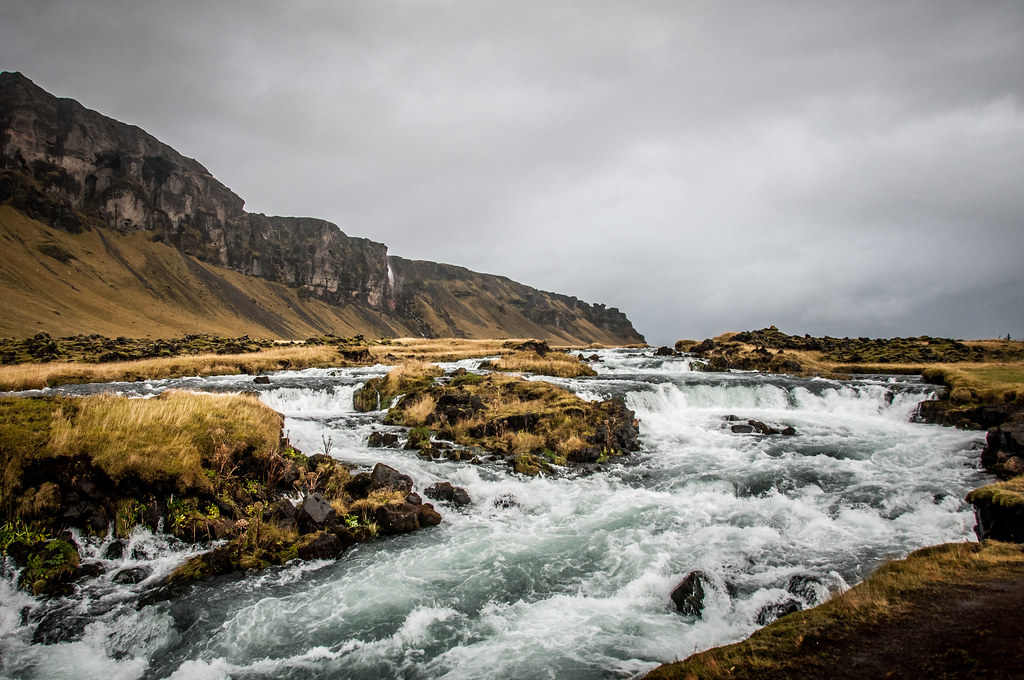
Iceland nature. Creative Commons Photo.
Shots were fired at a politician’s property recently for the first time in Icelandic folk’s memory. During the weekend of January 21-2, bullets from a .22 pistol were fired into Reykjavik Mayor Dagur B Eggertsson’s car and his office. He was not present in either occasion.
Two men were arrested and questioned. One man in his 60’s was remanded in custody during an investigation. Reykjaviks borgmester fandt skudhuller i sin bil efter ballade om p-plads – TV 2
On February 2, it was reported that the accused is a former police officer, Hallur Gunnar Erlingsson, and is considered dangerous. He was sentenced to 18 months in prison for sexually assaulting three young girls, in 2003. Former Police Officer Suspected of Shooting at Reykjavík Mayor’s Car – Iceland Monitor (mbl.is)
Eggertsson has been mayor since 2014. He is a member of the Social Democratic Alliance (a coalition of four parties including the traditional Social Democrats, a feminist and a green party). Speculation was rampant that the mayor had been hoarding three parking places in a city overloaded with personal cars. It turned out that he did not control those three spaces.
Despite the disclosure that the rumor was incorrect, the fact remains that the mayor’s car was parked before a three-story mansion that he owns. An architect designed square was built before his villa, which the mayor had arranged to be renovated with tax funds amounting to ten times what had been appropriated, according to Denmark’s Christian Daily newspaper. Island var kendt som verdens fredeligste land. Indtil borgmesterens bil blev ramt af pistolskud – Kristeligt Dagblad (kristeligt-dagblad.dk)
What this indicates is the deep-seated distrust that average Icelanders have for politicians, especially since the financial crisis of 2008.
Little Crime, Murder, Violence
While crime rates are low, and shootings most unusual, just four weeks after the shooting at the mayor’s care and office, an Albanian immigrant was shot several times in his home. He died of multiple wounds. This is the first shooting death since 2007. The dead man, 32, owned a physical security company. Eight persons have been arrested. Seven were in custody as of February 18. The key suspect is a Lithuanian immigrant. From Iceland — More Arrests In Reykjavík Shooting (grapevine.is)
Very few crimes involve firearms. Iceland has traditionally had a homicide rate of less than one per year for the last several decades. There have been 37 homicides in the last two decades. Four homicides in 2017 and four again last year were exceptional.
There are very few rapes. Nevertheless, reported rapes in 2015 numbered 178 (54 per 100,000), triple that of 2004 when the rate was 17.4 per 100,000 population. Greater porn media, tourism and immigration are partially responsible for this increase. Iceland Rape, 2003-2020 – knoema.com
Five percent of women in all of Europe reported having been raped, in 2014. In Iceland, even with the recent increase, just one tenth of one percent have experienced such violence. In the U.S., one in five women are raped, 19.3%.
Domestic violence, although infrequent, doubled last year to 60 cases over 30 in 2019.
Icelanders are generally not a violent people. In fact, they are deemed the most peaceful country in the world for 13 years running. • Chart: The State Of Global Peace In 2020 | Statista*
Not even Iceland’s police are violent.
On December 2, 2013, “Police in Iceland said they shot dead a gunman — the first time armed police have killed someone in the nation.” USA TODAY
Nothing similar has happened since. Police do not usually carry lethal weapons. The prime minister does not normally have body guards.
Police said that they were called to a Reykjavik suburb apartment when a 59-year old man fired a shotgun from his flat. Two unarmed police tried to enter the gunman apartment after neighbors complained he was making threats. They were shot at but not injured. Other policemen came armed. Witnesses said the police tried to subdue the man by throwing a smoke bomb into the apartment through a broken window. Two policemen were hit by shotgun fire, but not seriously. They fired at the man, who died when taken to a hospital. No one else was injured.
Crime, including shootings, is still low. This is what the U.S. Embassy reports:
“There is minimal risk from crime in Reykjavik…crime continues to be lower than in most developed countries and countries of similar size and demographics. The low level of general crime and very low level of violent crime [is] due to the high-standard of living, lack of tension between social and economic classes, small population, strong social attitudes against criminality, high level of trust in law enforcement, and a well-trained, highly-educated police force.” Iceland 2019 Crime & Safety Report (osac.gov)
Nevertheless, with the growth of the overpopulated Capital Region where 60% of the nation’s 365,000 people live in 1% percent of the country’s territory (95% in urban areas), coupled with increased tourism, immigration and refugees from poorer countries, petty crime and minor assaults increase. Police say that the rise in pickpocketing is a direct result of these new conditions. [i]
Some of the reasons why there is so little crime, even today, has to do with:
- Small country where people know one another, including their politicians and capitalists.
- Tight gun control. Everyone desiring to buy a firearm must be approved and registered by a state agency. Semi-automatic rifles are banned as are pistols, generally. There must be a special reason to own a pistol and it can take three-four years before permission is granted. A national database registers and tracks all firearms. Nevertheless, one in three persons own one or more firearms, which are used for hunting wild animals and for sports.
- Independence was declared in 1944, after 600 years of Danish rule. Iceland has never engaged in war.
Financial Crisis 2008
More people are politically conscious and motivated to take on corruption in politics and business in Iceland than in most countries.
Many thousands rallied at Reykjavik’s main square on freezing days between October 2008 and January 2009. They banged saucepans, linked arms in a circle around the parliament building, pelted it with food (too wasteful for my taste), and demanded the “left” government resign.
They succeeded in breaking the SDA-Independent Party coalition. An interim SDA-LGM (Social Democrats plus Left Green Movement) government won the April election. Yet again another “left” government also capitulated, this time to the EU and elite pressure. The government proposed a repayment deal “Icesave” to UK and Dutch creditors. The SDA-LGM government even announced drastic cuts in public spending. Hospital and school employees were laid off and wages cut. Some “leftist” politicians even suggested seeking membership in EU.
One of the few solid powers Icelandic presidents have is to sign proposed laws before they can be effected. President Olafur Ragnar Grimmson, a political science professor who replaced Vigdis, in 1996, took the unusual step of vetoing the appeasing bill to bailout customers of the private banks. In the ensuing referendum, March 2010, 93% of the people backed their president.
Despite this set-back, and a drastic slump in support, the “leftist” government tried once again to pay foreign creditors, this time in instalments. On 20 February 2011, President Grimmson again vetoed the bill. In the second referendum, April 9, 2011, Icelanders again rejected to pay $5 billion loans made by Britain and the Netherlands.
Sigmundur Daviõ Gunnlaugsson, head of the centrist Progress Party ran against the “leftist” coalition on a platform of “cleaning up” bank corruption and tax fraud. His party won parliament elections. He became PM, in May 2013. Sigmundur Daviõ worked with the president in refusing to pay the British and Netherland governments, a struggle finally sanctioned legally by the European EFTA Surveillance Authority. The centrist PM appeared more loyal to the people than the “leftists”.
(See: Smashwords – Scandinavia on the Skids: The Failure of Social Democracy – a book by Ron Ridenour and Welcome to Iceland, Where Bad Bankers Go to Prison – Bloomberg)
After the financial crisis, Iceland implemented capital control measures, which substantially reduced financial crimes and the illicit movement of money through Iceland. Most of these controls, however, were removed by new political leaders. This could lead to more economic corruption by the rich and those who seek to become rich.
Strong feelings of distrust for politicians, who often turn their backs on promises made, and opportunist businessmen and women, are now deep-seated in much of the population. In 2016, polls showed that two-thirds of the people had lost faith in The Establishment.
In April 2016, Iceland experienced its largest demonstrations in history. Up to 25,000 people protested outside the Prime Minister’s office in Reykjavik for several days. This non-violent yet determined protest was prompted by Panama Papers revelations showing that several senior Iceland officials (including PM Sigmundur Daviõ Gunnlaugsson and his finance minister) had large investments in foreign corporations and in tax shelters, in order to circumvent Iceland’s austere capital controls.
The public outcry over these revelations forced Gunnlaugsson to resign on April 7, 2016.
For the entire year of 2016-7, the activist citizenry persisted in challenging leading politicians. Social Democrats also became discredited for their right turns, as well as the traditional liberal/neo-liberal Progressive Party. The nation had four prime ministers within a year’s time. The current prime minister, Katrín Jakobsdóttir, has been such since November 2017 parliamentary election, in which 81% of potential voters went to the polls.
Educated in Icelandic literature, the 45 year-old Jakobsdóttir is a popular leader of the Left-Green party. It won second place with 17% of the vote giving it 11 seats of the 64-member Althing (meaning Assembly in Fields) parliament. The Independence party is the largest with 16 seats.
Left-Green leads a coalition government. It stands for democratic socialism, withdrawal from NATO and EU, opposes U.S. aggressive wars, and emphasizes feminism (full equality of genders, ethnicity, nationalities, and religion), integration of immigrants, and environmentalism.
The Althing convened first in 930 with citizenry meeting outdoors to determine how they should conduct their economy and politics. In 1262, Iceland came under first Norway and then Denmark monarchies. The Althing is the world’s oldest parliament.
Isolated from Denmark once the Danish government accepted Nazi rule, on April 9, 1940, Iceland allowed the United States to build a military base at Keflavik, near Reykjavik airport. On June 17, 1944, the Althing decreed Iceland’s independence from Denmark, and became a republic.
Presidents are elected every four years and have no term limits. Although presidential powers are limited, she/he has more powers than other European presidents and monarchs where prime ministers have nearly total power. After general elections, Icelandic presidents designate a party leader to form a government—the one that the president considers most likely to be able to form a majority coalition government. The president also appoints cabinet ministers proposed by the PM, and determines their number and division of assignments. Ministers are not able to resign. Only the president can discharge them.
There are currently 11 ministers. There is no minister of defense or war! It is the task of Iceland’s coast guard to fulfill the nation’s limited responsibilities to NATO.
Keflavik Military Base
Another topic of public discord concerning PM Gunnlaugsson was his acquiescence to the U.S. Navy, allowing it to retake the Keflavik base just two months before he was ousted, April 7, 2016, for corruption and tax evasion.
The U.S. Army had built the base, in order “to maintain the defense of Iceland and secure northern Atlantic air routes. It served to ferry personnel, equipment, and supplies to Europe. Intended as a temporary wartime base under an agreement with Iceland and the British, U.S. forces withdrew by 1947 but returned in 1951 as the Iceland Defense Force resident on a North Atlantic Treaty Organization (NATO) base.”
Boeing P-8 Poseidon – Wikipedia. Also see: NATO BASE KEFLAVIK AIRPORT BASE HISTORY – NAT; U.S. military returns to Iceland | The Independent Barents Observer (thebarentsobserver.com)
On 8 September 2006, the U.S. turned over the base to the Icelandic Defense Agency as their primary base until January 1, 2011, when the Agency was abolished and the base handed over to the Icelandic Coast Guard. The coast guard serves Iceland’s functions as a member of NATO, which the republic had joined in 1949. Under Iceland, the base had served primarily as a radar and communications site.
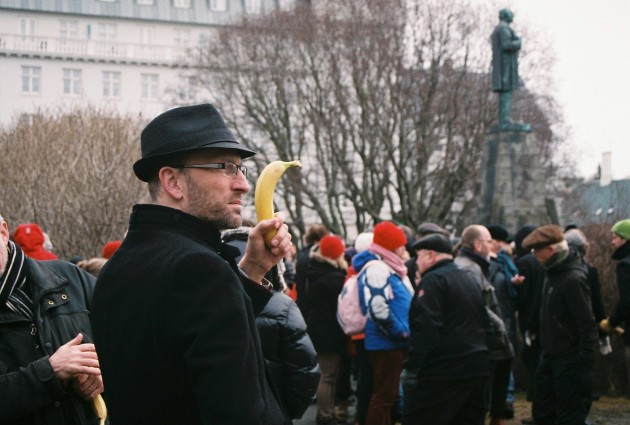 No to Banana Republic. Photo from Hannah’s blog. Iceland | It All Started In Iceland… (wordpress.com)
No to Banana Republic. Photo from Hannah’s blog. Iceland | It All Started In Iceland… (wordpress.com)
In 2017, the United States announced its intention to “improve” the base. Its contention is that it needs the base to “deter Russian aggression”.
“At Naval Air Station Keflavik, Iceland, slightly more than $14 million is being invested to build new hangars to house sub-hunting Navy P-8 Poseidon aircraft, according to Foreign Policy.” US plans $200 million buildup of European air bases flanking Russia (airforcetimes.com)
Retaking Keflavik is part of Russiaphobia, which Donald Trump partially fell for. He designated $214 million to repair and build ten U.S. military bases in Norway, Estonia, Latvia, Luxembourg, Romania, Hungary, Slovakia as well as Iceland. At some bases, high tech stealth fighters will be employed.
Public demonstrative outrage against U.S. military presence on this peaceful island nation has taken place periodically since Iceland joined NATO. Bjarni Benediktsson, Iceland’s foreign minister, was a strong advocate for NATO. He was a leading figure in the conservative capitalist Independence Party, and became prime minister, 1963-70. While the Independence Party opposed Denmark’s colonialism, it desired “protection” from the United States.
On March 30, 1949 parliament voted (37-13) to join NATO. Besides Benedikstsson’s party, the Social Democrats and Progressive parties voted for; opposed were Nationalists and Socialists.
Socialists led an anti-NATO march on parliament where pro-NATO demonstrators awaited them. Fisticuffs ensued amongst egg and rock throwing. Many parliament windows crashed. The uproar lasted for hours. Police finally broke it up using batons and tear gas, which police did not use against demonstrations again until the financial crises of 2008.
On April 4, Iceland joined 11 other countries, including Denmark, to found NATO. NATO – Declassified: Iceland and NATO – 1949
Since then, many people continue to oppose NATO and Iceland’s membership. They may be the majority, because the parliament has refused to let the people vote on the issue in a referendum. The “Campaign Against Militarism” demonstrates with banners “Iceland Out of NATO” and “The Army Out”. The big question is, once the U.S. gets its grip on a nation can the people kick it out?
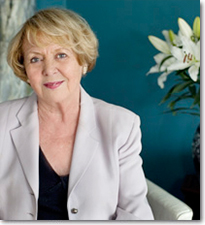
Vigdis Finnbogadottir
World Theatre Day – International Theatre Institute ITI (world-theatre-day.org)
On June 29, 1980, Vigdis Finnbogadöttir became the world’s first female elected president, and the first single mother president. Vigdis has long been one of those anti-NATO activists devoted to world peace.
She granted me an interview just four months after taking office. I flew from Denmark to meet with her. I had married a Danish woman, Grethe.
“Whenever I speak as head of state, I speak about peace. I will say it as often and as long as necessary,” the straight-talking President Vigdis Finnbogadöttir told me. Smashwords – Scandinavia on the Skids: The Failure of Social Democracy – a book by Ron Ridenour
“Think what we could do with the money that goes into militarism! I am a premeditated pacifist. Wars and armies are absurd things. We have no army, no militarism. We are a peaceful, independent people,” asserted the charismatic, mild-mannered president.
Vigdis told me that she had demonstrated scores of times against the Keflavik military base, often marching the 50 kilometers from Reykjavik to the base.
The president was never a member of any political party. She was a cultural worker educated in French literature at the Sorbonne. When elected president, she was artistic director of the Reykjavik City Theatre.
“I think my election was the result of the woman’s day strike we had on October 4, 1975. No lady did a thing the whole day. I was striking like everybody else, as were all my actresses.”
The United Nations had proclaimed 1975 as Women’s Year. A committee made of five Icelandic women organizations organized a protest day for equal wages and equal treatment. Ninety percent of women did no housework; most did not go to their jobs; and 25,000 demonstrated (out of a 220,000 population). Many pointed to Vigdis as their choice for president.
“We have accomplished a lot for such a small population. We have no real poverty, hardly any unemployment, everyone has food and shelter. And Imagine! We succeeded in harnessing the strong elements of nature: ice, rapid waters, fire, and even lava. We are the only nation to detour a lava stream to save a village and then used the lava to heat all the homes not destroyed,” President Finnbogadöttir concluded.
Vigdis served four terms (August 1980-April 1996), the longest serving president in Iceland ever. At 91 years, she is still serving peace as UNESCO’s Goodwill Ambassador, so chosen in 1998.
Having witnessed some of this wonderful island nation to meet its peace activist president, I returned in 1981 to work on a fishing boat at the small island of Heimaey, Vestmaanaeyjar Vigdis spoke of. I had also become familiar with the island, because of the 1973 eruption of Eldfell Volcano (Hill of Fire). The eruption destroyed a fifth of its buildings, 400 homes; 5300 residents were evacuated, and no one was killed. A crew remained to put out the fires with ocean water, cool down the lava flow, which was then converted into heat energy for their remaining homes. This process took half a year, and then 85% of the inhabitants returned. Eldfell – Wikipedia
I was offered a summer job at Heimaey. This 13 square kilometer island of 4500 residents, with 3000 cars, was still a major fishing village. Grethe soon came and worked in a factory cleaning the fish that we and other small fishing boats netted. These jobs are grueling work.
When there was a break, waiting for our nets to catch fish, several men and teenage fishers would take out their chess boards. I play a bit, so I watched my mates make their quick and effective moves. Most of them had only the minimum of education, 10 grades, yet all were excellent players. When I asked if I might try my hand, there was a hush. No one wanted to reply. I learned from my native “guide”, who had found me work and a place to live, that they were shy and embarrassed. They didn’t want me to feel left out or ignored. On the other hand, they didn’t want me to play because, without knowing how good I might be, they surmised that I wouldn’t last two minutes. When this was explained, I understood and appreciated their reasoning completely.
Chess players will remember the famous 1972 world championship between Soviet Boris Spassky and U.S. American Bobby Fischer, which was played at Reykjavik. The reality is Iceland has more rated grandmasters per population than any other country. The World’s Most Chessly Nation Is… ÍSLAND! – Chess.com
Culture
Iceland is known for its moon-like, volcanic nature. Icelanders are known for their pony-sized horses, and for their sagas (Íslendingasögur). These family prose narratives are generally based on historical events, which mostly took place in Iceland in the ninth, tenth, and early eleventh centuries. This so-called Saga Age is the best specimen of the island’s literature. They were written in Old Icelandic, a western dialect of Old Norse.
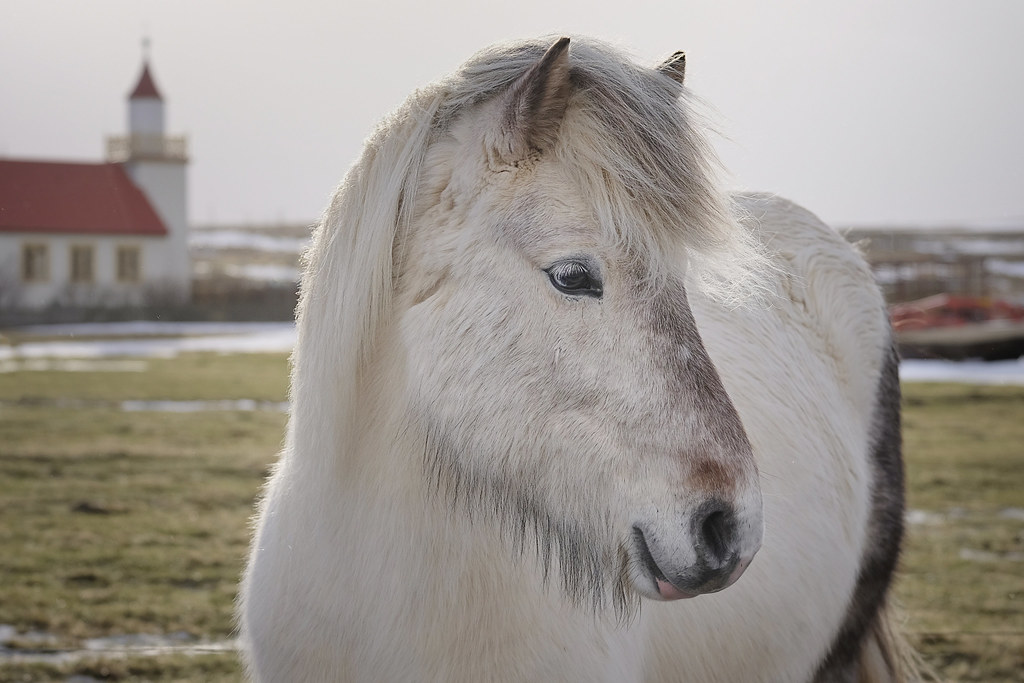
Icelandic pony-horse. Creative Commons photo.
In modern times, Icelandic authors write marvelous novels, detective stories, and poetry. Many ordinary citizens write their own poetry. In fact, 10% of the people publish one or more books. More books are published and sold per person in Iceland than in the world, and there are more book stores per capita. Most people actually read books.
Iceland Has the Most Books Published per Person per Year in the World (funfactz.com)
Icelandic culture is one of the richest in the world, in part, because nearly everyone feels connected. Icelanders appreciate theater, symphonies, even opera. There are many art galleries, professional theaters, museums, and cinemas. Filmmakers are world class.
Cuisine is based on the many varieties of fish from their waters, and lamb. Haddock is their favorite. Fish, especially cod and redfish, is their largest export product.
Gender equality is widely successful and respected. Many women hold leadership positions in government and business. Gay rights are legislated and largely accepted. Same gender couples have been able to register in union since 1996, adopt children since 2006, and marry since 2010. Women retain their sur names after marriage.
The 2003 Children’s Act outlawed spanking, even verbal and emotional abuse. Physical or mental violence is punishable by imprisonment and/or fine.
When I moved to Denmark, I began reading books written by Scandinavians. My first Icelandic author was Halldór Laxness. He wrote novels, short stories and poetry. Laxness drew from Bertold Brecht, Upton Sinclair, Sinclair Lewis and Ernest Hemingway, among others. He even translated Hemingway’s Farewell to Arms.
Laxness is best known for Salka Valka, a sociological novel depicting a girl of nature who fights for justice, for union rights and livable working conditions. This book began a series of social critical novels in which socialism is the preferred economic order. Laxness won the Lenin Peace Prize, in 1953, which did not prevent the Swedish-based institution from granting him the Nobel Prize for Literature, in 1955.
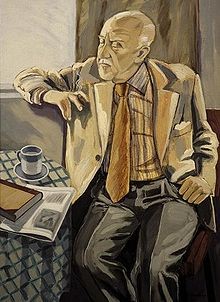
Halldór Laxness painted by Iceland artist
Einar Hákonarson – Wikipedia
Small Societies Can Be Peaceful; Large Ones Are Violent
We all can learn from the Icelandic people, from their sense of assuming responsibility, for their tenacity, and for their tight-knit fellowship. I am concerned, however, that if the current trend in Iceland, especially in the ever-growing Capital Region, persists this peaceful and thoughtful people could deteriorate into consumerism like most others in the world when they have the chance. Drug smuggling, rampant pornography, money gouging by businessmen and some politicians, tourism accompanied with growing crime, too many cars, the presence of the U.S. military base and soldiers trained to kill, are all signs of decaying humanistic values, and a diminishing democracy.
When Jean-Jacques Rousseau used the word democracy, he referred to a direct democracy rather than a representative one. Rousseau argued that only small city-states are the form of nation in which freedom and peaceful relations can possibly flourish.
In his most influential work, The Social Contract (1762), “Rousseau asserts that democracy is incompatible with representative institutions… [T]he moment a people allows itself to be represented, it is no longer free: it no longer exists.’” Democracy – Rousseau | Britannica
Rousseau was pessimistic about the long run viability of any form of government where the society has too many human beings. He did not set any number that might be “too many”. He hints, though, at the possibility “that democratic governments may be viable if joined together in confederations.”
Anthropologists have concluded that when homo sapiens lived in small groups (20-to a couple hundred) it was possible to live with one another in relative peace, and with relative democratic-decision making. Each person had his/her tasks, and no person could occupy a leading position without authentic skill and without consent of the group.
In my opinion, we homo sapiens are doomed to murder one another individually and in massive scales because: 1) we insist upon constructing huge societies, which are dominated by a few persons bent on obtaining endless wealth by any means; 2) we insist upon bearing too many children.
The planet is already over-populated and cannot sustain the human race as it is. Is the Earth over-populated? (phys.org) and The Ecological Footprint: 1.7 Earths are needed to support our demands! | Sustainability Academy (sustainability-academy.org)
Parents worldwide should bear no more than one child for some time to come. This is the only sane approach. Another “only sane approach” is to end all forms of economic greed in the whole world.
In the words of Evo Morales’ Ten Commandants: Live Well, not Live Better.
“Sisters and brothers, [in] the tenth point, we propose to Live Well, not live better at the expense of another—a Live Well based on the lifestyle of our peoples, the riches of our communities, fertile lands, water and clean air. Socialism is talked about a lot, but we need to improve this socialism, improve the proposals for socialism in the XXI century, building a communitarian socialism, or simply Live Well, in harmony with Mother Earth, respecting the shared life ways of the community.Evo Morales: 10 Commandments To Save the Planet | Climate & Capitalism (climateandcapitalism.com)
[i] Immigration was negligible until the turn of the century. In 2019, there were 62,000 immigrants. While 17% of inhabitants are recent immigrants, 91.5 of the population are citizens.
In 2000, 300,000 tourists came. Recent numbers are 2.3 million. Employment in tourism is 15% of the workforce, topping all other forms of work. Some tourists stay to work in the industry. Tourism accounts for 10% of GDP and 30% export revenues. The fishing industry accounts for 11% GDP and 40% export revenues with just 5 % of the workforce. Aluminum and animal meal follow.
RON RIDENOUR is a US-born journalist and anti-war activist living in Denmark. He is a member of www.thiscantbehappening.net His books, “The Russian Peace Threat: Pentagon on Alert” and ‘Winding Brook Stories’ are available at Amazon and Lulu. His other work can be found at ronridenour.com; ronrorama@gmail.com
